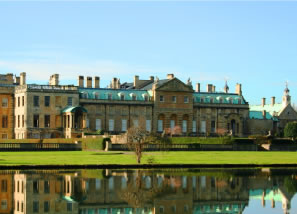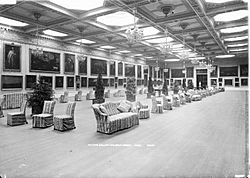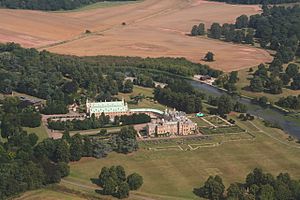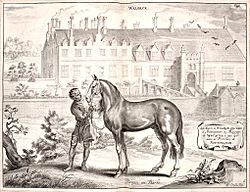Welbeck Abbey facts for kids
Quick facts for kids Welbeck Abbey |
|
|---|---|

Welbeck Abbey during the
2007 summer floods |
|
| General information | |
| Coordinates | 53°15′44″N 1°09′22″W / 53.262150°N 1.156029°W |
| Owner | Dukes of Newcastle and Dukes of Portland |
| Designations | Grade I listed building |
Welbeck Abbey is a historic estate in North Nottinghamshire, England. It was once a monastery for a religious group called the Premonstratensian order. After the Dissolution of the Monasteries, it became a grand country house and home to the Dukes of Portland.
Welbeck Abbey is part of an area known as the Dukeries, which includes four large estates owned by dukes. The main house is a Grade I listed building, meaning it is a very important historical site.
Contents
History of Welbeck Abbey
The land where Welbeck Abbey stands was first mentioned in the Domesday Book, a famous survey from 1086. It belonged to a person named Hugh fitzBaldric.
From Monastery to Country Home
In 1140, Thomas de Cuckney founded a religious house here. It was an abbey for Premonstratensian canons, who were a type of priest living in a community. The abbey was dedicated to St James the Great. Over time, the abbey became very wealthy. It received many gifts from important families in Nottinghamshire and even a large grant from King Edward I.
By 1393, the abbey was so powerful that King Richard II launched a serious investigation into its affairs. The Abbot of Welbeck was a very influential man because of the abbey's wealth. In 1512, all the houses of the Premonstratensian order in England were placed under his leadership.
In 1538, during the Dissolution of the Monasteries (when King Henry VIII closed down monasteries), the abbot, Richard Bentley, received a pension of £50. The 17 canons (priests) also received pensions.
After the dissolution, King Henry VIII gave the site to Richard Whalley. Later, it was bought by Gilbert, 7th Earl of Shrewsbury, in 1599. In 1607, it was sold to Sir Charles Cavendish, whose mother was Bess of Hardwick.
The estate then passed to Sir Charles's son, William Cavendish, who later became the first Duke of Newcastle. The Cavendish family turned the abbey into a country house. They added a riding house in the 17th century, designed by Robert Smythson and his son John. Only the basements and inner walls of the old abbey remained.
In the 18th century, Welbeck Abbey passed to the Bentinck family through an heiress. It became the main home for the Earls and Dukes of Portland.
Recent History of Welbeck
In October 1900, the Oxford Wing, one of the oldest parts of the building, caught fire. Most of the valuable items inside were saved. The wing was rebuilt by 1905, following designs by Ernest George.
In 1913, Archduke Franz Ferdinand, whose assassination later started World War I, visited Welbeck Abbey. He was invited by the 6th Duke of Portland. During his stay, he narrowly avoided a hunting accident.
During World War I (1914-1919), the kitchen area of the abbey was used as an army hospital. After World War II, the Dukes of Portland leased Welbeck Abbey to the Ministry of Defence. It was used as Welbeck College, a training college for the army, until 2005. The author Bill Bryson wrote about his visit to the abbey when it was occupied by the Ministry of Defence in his book Notes from a Small Island.
After the Ministry of Defence moved out in 2005, Welbeck Abbey became the home of William Henry Marcello Parente. He inherited the estate from Lady Anne Cavendish-Bentinck, the elder daughter of the 7th Duke, who lived at Welbeck Woodhouse.
Today, the Welbeck Estates Company and the Harley Foundation have transformed some of the estate buildings. These now include the Dukeries Garden Centre, The School of Artisan Food, the Harley Gallery and Foundation, and the Welbeck Farm shop. There are also craft workshops. Visitors can explore parts of the estate using footpaths that are part of the Robin Hood Way.
Welbeck Abbey has also hosted events. In 2012, the first No Direction Home Festival was held there. In 2016, the BBC's baking show Bake Off: Crème de la Crème used the abbey as its filming location.
Architecture and Unique Features
The 5th Duke of Portland made the most significant changes to Welbeck Abbey. He was known for his unusual building projects.
Underground Wonders
The 5th Duke built an enormous riding house, which was 396 feet long, 108 feet wide, and 50 feet high. At the time, it was the second largest riding house in the world. Nearby, he built a "tan gallops" that was 422 yards long. This area was lit by 4,000 gas jets and heated, allowing horse training even at night or in winter. The "Tan Gallops" got its name from the soft oak chips that covered its floor, which were good for horses.
A tunnel, over a thousand yards long, connected the main house to the riding school. It was wide enough for several people to walk side by side. Another, rougher tunnel ran parallel to it for workmen. The Duke also started building a much longer, more elaborate tunnel, one and a half miles long, designed as a carriage drive. This tunnel was meant to be wide enough for two carriages to pass. However, it was abandoned in the late 19th century when a part of it, which was also part of a lake dam, failed. You can still see parts of this tunnel today. Its skylights are visible from the Robin Hood Way footpath.
The 5th Duke also created several extensions to the mansion that were "below ground." These were not fully underground but had flat roofs and skylights that were hidden by plants. The largest of these is a great hall, 160 feet long and 63 feet wide. It was meant to be a chapel but was used as a picture gallery and sometimes as a ballroom. There was also a set of five rooms built to hold the Duke's large library.

The Duke also made many changes to the house above ground, adding fancy bathrooms and new lodges at the park entrances.
These building projects cost a huge amount of money and employed thousands of workers, including masons, bricklayers, and plumbers. The Duke was well-liked by his employees and was even nicknamed "the workman's friend" because he created so much employment.
By 1879, Welbeck Abbey was in poor condition. The 5th Duke only used a few rooms in the west wing, which were painted pink and had bare parquet floors. Each room even had a water closet in the corner.
The house was later repaired by the 6th Duke. It became a popular place for high society events in the late Victorian and Edwardian eras. The 6th Duke loved horses. He built almshouses (homes for poor people) on the estate, which were funded by money his horses won in races.
Today, Welbeck Abbey, its picture gallery, chapel, and library are all Grade I listed buildings. The beautiful park around it is also listed as Grade II on the Register of Historic Parks and Gardens. Several other structures on the estate, like the lodges, grotto, and sunken garden, are also listed for their historical importance.
Welbeck Woodhouse
A smaller house called Welbeck Woodhouse was built on the northern side of the estate between 1930 and 1931. It was built for the Marquess of Titchfield, who later became the 7th Duke. This house became the main home for the Cavendish-Bentinck family when the main abbey was leased to the Ministry of Defence.
Owners and Occupiers of Welbeck Abbey
- ca 1086 Hugh FitzBaldric
- 1140 – 1538 Premonstratensian canons in the Abbey of St. James
Abbots of Welbeck Abbey (Selected)
- Berengar, 1153-1169
- Adam, 1183-1194
- Richard, 1194-1224
- William, 1229-1243
- Richard, 1250-1257
- Adam, 1263-1276
- Thomas, 1281-1292
- John de Duckmanton, 1309
- John de Cestrefeld, 1310
- William de Kendall, 1316
- John de Nottingham, 1322
- William de Aslakeden, 1335
- Robert Spalding, 1341
- John de Wirksop, 1349
- Hugh de Langley, 1360
- George de Gamelston, 1369-1387
- William de Staveley, 1389
- John Bankwell, 1393
- John de Norton, 1412-1450
- John Greene, 1450
- William Burton, 1475-1482
- John Lancaster alias Acastre, 1488-1491
- John Copper, 1492
- Thomas Wydur, 1494-1500
- Robert, 1502
- Thomas Wilkinson, 1503
- John Maxey, 1520-1536
- Richard Bentley, surrendered 1538
Manor Owners (Selected)
- 1538 – 1558 Richard Whalley of Screveton
- 1558 – 1595 Edward Osborne of London
- 1595 – 1599 Robert Booth and Ranulph Catterall
- 1599 – 1607 Gilbert Talbot, 7th Earl of Shrewsbury and Mary Talbot, Countess of Shrewsbury
- 1607 – 1617 Sir Charles Cavendish
- 1617 – 1676 William Cavendish, 1st Duke of Newcastle-upon-Tyne
- 1676 – 1691 Henry Cavendish, 2nd Duke of Newcastle-upon-Tyne
- 1691 – 1711 John Holles, 1st Duke of Newcastle-upon-Tyne and Lady Margaret Cavendish
- 1711 – 1734 Edward Harley, 2nd Earl of Oxford and Earl Mortimer and Lady Henrietta Cavendish Holles
- 1734 – 1785 William Bentinck, 2nd Duke of Portland and Margaret Bentinck, Duchess of Portland
- 1785 – 1809 William Cavendish-Bentinck, 3rd Duke of Portland
- 1809 – 1854 William Bentinck, 4th Duke of Portland
- 1854 – 1879 William Cavendish-Scott-Bentinck, 5th Duke of Portland
- 1879 – 1943 William John Arthur Charles James Cavendish-Bentinck, 6th Duke of Portland
- 1943 – 1977 William Arthur Henry Cavendish-Bentinck, 7th Duke of Portland and Ivy Cavendish-Bentinck, Duchess of Portland
- 1943 – 2005 Ministry of Defence (leasing most of the abbey)
- 1977 – 2008 Lady Anne Cavendish-Bentinck
- 1992 – present Bentinck and Parente families (occupying part of the abbey)
|





